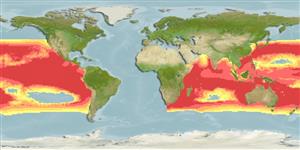Classification / Names
Common names from other countries
Main reference
Size / Weight / Age
Max length : 230 cm TL male/unsexed; (Ref. 9308); common length : 190 cm TL male/unsexed; (Ref. 9308); max. published weight: 52.0 kg (Ref. 43)
Environment
Marine; pelagic-oceanic; oceanodromous (Ref. 51243); depth range 0 - 1830 m (Ref. 86942), usually 0 - 350 m (Ref. 89423)
Climate / Range
Subtropical, preferred 28°C (Ref. 107945); 43°N - 56°S, 20°E - 68°W
Distribution
Indian and Pacific: tropical and temperate waters. Although some stray individuals are found in the Atlantic Ocean, this species is believed to have its spawning grounds and principal populations only in the Pacific and Indian Oceans. Highly migratory species, Annex I of the 1982 Convention on the Law of the Sea (Ref. 26139).
Countries | FAO areas | Ecosystems | Occurrences | Introductions
Short description
Dorsal
spines
(total): 0;
Dorsal
soft rays
(total): 51-57;
Anal
spines: 0;
Anal
soft rays: 18 - 23. Dark blue above, blue splattered with brown on the sides, silvery white below; 1st dorsal fin plain dark blue, other fins brown or dark brown; anal fin bases with tinges of silvery white.
IUCN Red List Status (Ref. 115185)
Threat to humans
Harmless
Human uses
Fisheries: minor commercial; gamefish: yes
More information
ReferencesAquacultureAquaculture profileStrainsGeneticsAllele frequenciesHeritabilityDiseasesProcessingMass conversion
Tools
Special reports
Download XML
Internet sources
Estimates of some properties based on models
Phylogenetic diversity index
PD50 = 0.5630 many relatives (e.g. carps) 0.5 - 2.0 few relatives (e.g. lungfishes)
Trophic Level
4.5 ±0.76 se; Based on food items.
Resilience
Medium, minimum population doubling time 1.4 - 4.4 years (Assuming tm=2-4)
Vulnerability
Moderate vulnerability (42 of 100)
Price category
